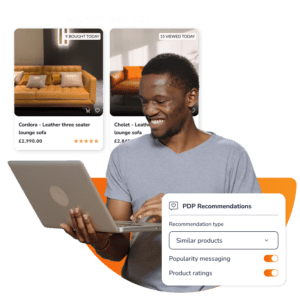Email marketing is a powerful customer engagement tactic but standing out in a crowded inbox and ensuring a high click-through rate (CTR) can be challenging. Incorporating personalized product recommendations into your email campaigns can significantly enhance engagement and CTR. This blog post discusses the significance of CTR and the impact personalized product recommendations have on the metric and then provides some recommended strategies for using personalized product recommendations to enhance your email marketing performance.
First, just how important is CTR?
Click-through rate (CTR) is a pivotal metric in email marketing. Essentially, CTR measures the effectiveness of an email campaign in driving user engagement by showing the percentage of recipients who clicked on links or calls to action in an email. A high CTR means that the recipients found the content compelling enough to take action (e.g., click through to a website or product page or perform another action suggested in the email).
A high CTR is a positive indicator that you will achieve your campaign goals (i.e., improved sales, increased website traffic, enhanced customer engagement, etc.) and suggests that the content, personalization, relevance, and call-to-action strategies you’ve employed have effectively captured the audience’s attention and prompted actions that align with your campaign goals. Moreover, higher CTRs often correlate with better deliverability and positively impact email sender reputation.
What role do personalized product recommendations play in CTR?
Personalized product recommendations are an email marketing game-changer. When you tailor content such as this to match your customer’s preferences, behavior, and past interactions, you significantly increase the relevance of your emails and the likelihood the recipient will engage with the content and make a purchase or take an action that you’ve outlined (i.e., register for an event, sign up for an email list, download your app, etc.).

The impact of personalized product recommendations on CTR is profound. When customers receive product suggestions aligned with their interests or past purchases, they are more likely to click through and explore further. Not only does this elevate CTR, but it also enhances the overall customer experience, fostering a sense of personal connection with your brand.
Nine steps to emailing personalized product recommendations
A comprehensive approach ensures that personalized product recommendations enhance the relevance and engagement of email content, boost CTR and drive conversions.
Follow our proven 10-step approach for a more effective email marketing program.
1. Collect customer data.
We recommend basing your personalization on zero- (i.e., directly obtained from your customers) and first-party data (i.e., behavioral data collected from customer interactions). These are the most reliable forms of data as they are collected directly from your customers and your customer interactions. Use surveys, pop-ups, and preference centers to collect zero-party data. Browsing history, cart behavior, and purchase history will make up the bulk of your first-party data. This data will serve as the foundation for personalized product recommendations.
2. Choose a product recommendation engine.
A product recommendations engine will use your customer and product catalog data to automatically serve up personalized recommendations for each customer. For instance, if a shopper clicks on turtlenecks, the recommendation engine will show turtlenecks she hasn’t yet seen. It might also show similar brands to the current turtleneck brand or similar categories (e.g., women’s mock turtlenecks, women’s cardigans, etc.).

3. Create dynamic email templates.
To implement dynamic content, you need a system that automatically pulls data from your eCommerce website, ESP, and customer database in near real-time to deploy personalized content across channels. Fresh Relevance gathers data wherever your customers go and brings it all together for real-time analysis and insight.
Dynamic content lets customers see the content and type of content that’s most appropriate for their context, personalized in real-time based on their profile and interests. And Fresh Relevance SmartBlocks make it easy. SmartBlocks are blocks of dynamic, personalized content you can add to any email or webpage — not just pages in your eCommerce system or emails from your ESP.
It’s easy to create and edit reusable templates because SmartBlocks uses standard HTML and CSS and Fresh Relevance provides a lot of templates to get you started. Best practices tip: Set up your first two personalized product recommendations email templates using open-time inventory and pricing data to ensure consumers aren’t disappointed by an offer that’s expired or is no longer available.
Insider tip: Since this post is about how personalized product recommendations increase CTR, I won’t go into all of the other ways you can personalize your emails with dynamic content. But please make sure you check out the many dynamic content examples!
4. Segment your email list.
This is a marketer’s meat-and-potatoes step, so I won’t dig in too deeply here. To begin, you need a good understanding of your audience, your business and marketing goals, and your market.
Divide your email list into key segments based on demographics, interests, preferences, and behavior (see zero- and first-party data references above). Create and send personalized content to each segment, ensuring that product recommendations are targeted and relevant.
Here are 3 great resources about segmentation, targeting, and personalization for eCommerce:
- The complete guide to market segmentation
- The complete guide to online behavioral targeting
- 9 types of behavioral segmentation you should be using to drive conversions
5. Include social proof and reviews.
To make your personalized product recommendations even more powerful, add social proof. Integrate user-generated content such as reviews, ratings, and customer testimonials into your email content. Social proof enhances trust and encourages recipients to explore recommended products.
“We’ve seen a 13% increase in sales using Fresh Relevance’s social proof features in our email marketing.”
Charles Kraus
Senior CRM Manager at Buyagift
6. Craft compelling subject lines and email copy.
Seems like a no-brainer, right? Maybe. But, we can do better than just leading with emojis, @Name, or pithy subject lines. Here’s another great place to show that you know your customer by starting your communication with the product they recently shopped for. That’s exactly what this designer fashion retailer did with their Black Friday cart abandonment series.
The retailer found that dynamic subject lines featuring the carted brand outperformed emails with subject lines containing the customer’s name by 5%.
And that’s not all.
During the Christmas period, dynamic subject lines containing the browsed brand outperformed subject lines with name personalization by 209%.
Use this automated tactic for other personalized product recommendations to send your CTR numbers through the roof!
7. Test and optimize.
Use AI-powered testing and optimization capabilities to constantly monitor and deploy your best-performing data sources for product recommendations to ensure maximum ROI and a highly relevant customer experience. This capability is particularly useful for time-bound events (i.e., Black Friday, Valentine’s Day, etc.).
“Auto Optimize is simple to use and has saved us a lot of time. It runs automatically in the background, not like a split test where you have to keep an eye on it all the time. It ensures we’re getting the results we need.”
Georgia Bell
SEO & Email Executive at Direct365
8. Ensure a seamless experience across channels.
Some recommendation engines only work for one channel. That’s more work for you and produces a subpar customer experience. Opt for an omnichannel-capable recommendation engine that spans multiple channels and delivers the appropriate tailored content to each channel.
This is especially critical for personalized recommendations. For instance, if a shopper clicks on specific clothing items but leaves the browsing session, an ideal recovery tactic is to quickly send an automated browse abandonment email displaying the product she was interested in and some personalized product recommendations.
But, what if she doesn’t open the email? When she visits your site next, you want a recommendation engine that can provide her with a personalized product feed based on her previous browsing and buying behavior.
9. Implement behavioral triggers.
Use triggers based on customer behavior, such as cart abandonment, price drops, back-in-stock, and refill reminders. Triggered emails result in more timely and relevant recommendations. Customize your triggered emails based on the type of shopper, carted value, etc., and add conversion-boosting elements such as personalized product recommendations and social proof.
“We had a very basic cart abandonment set up before. The emails were non-personalized, they didn’t show the products and they didn’t include social proof. Now with Fresh Relevance, we’ve seen a 25% increase YoY in abandoned cart revenue.”
Nathan Amery
Head of Digital Marketing, Jewellerybox
Wrapping it up
Personalized product recommendations have a significant impact on email marketing CTR. By understanding the importance of CTR, leveraging personalized recommendations, and employing comprehensive strategies, businesses can enhance engagement, drive sales, and build stronger relationships with their audience. Investing in tailored and relevant content not only improves the customer experience but also amplifies the effectiveness of email marketing initiatives.






